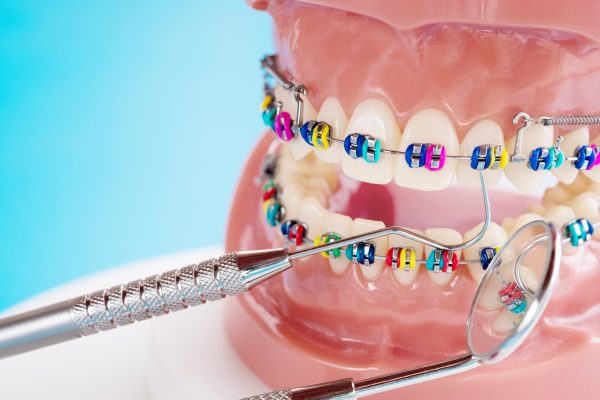Invisalign® vs Braces: Which Orthodontic Treatment is Right for You?
If you’re considering orthodontic treatment to improve your smile, you may be wondering which option is right for you. Both Invisalign® and braces are effective ways to straighten teeth and correct bite issues, but they each have their own unique advantages and disadvantages.
Dr. Dawson’s goal is to provide you with the information you need to make an informed decision about your orthodontic care.

Comparing Invisalign and Braces
Appearance
- Invisalign: As the name suggests, Invisalign is nearly invisible. They consist of clear, plastic aligners that fit over the teeth, making them a more discreet option.
- Braces: Traditional braces consist of metal brackets that are adhered to your teeth and connected by a wire. They’re more noticeable than Invisalign.
Costs
- Invisalign: Generally, Invisalign tends to be more expensive than traditional braces. Patients can expect to spend between $3,000 to $8,000, as costs differ depending on factors such as location, insurance coverage, and the time of treatment.
- Braces: Traditional braces are typically less expensive than Invisalign, but the cost can vary based on the complexity of the treatment and geographical location. On average, braces costs between $3,000 to $7,000.
Treatment Time
- Invisalign: Treatment time with Invisalign is typically between 12 to 18 months, but it can vary depending on the complexity of the case.
- Braces: Traditional braces often need to be worn for about 24 months, although this can also vary.

Comfort
- Invisalign: Invisalign aligners are made of smooth plastic, making them more comfortable than braces. They also can be removed, allowing for relief if discomfort arises.
- Braces: Braces are fixed onto the teeth and can cause irritation to the inside of the mouth. The adjustment process can also create discomfort.
Maintenance
- Invisalign: Clear aligners should be cleaned regularly and taken out while eating or drinking anything other than water.
- Braces: Braces require careful cleaning around the brackets and wires. Certain foods that can damage or get stuck in braces must be avoided.
Versatility
- Invisalign: Invisalign is great for correcting a wide range of orthodontic issues, but complex cases may still require braces.
- Braces: Braces are extremely versatile and can correct a wide range of complex orthodontic problems.
Check-Ups
- Invisalign: You’ll need to see your orthodontist every 4 to 6 weeks, and you’ll switch to a new set of aligners every 1 to 2 weeks.
- Braces: You’ll typically see your orthodontist for a tightening every 4 to 6 weeks.

Frequently Asked Questions
Yes, Invisalign is generally considered to be less painful than traditional braces. The reason for this is that Invisalign uses a series of smooth plastic aligners that are custom-made to fit your teeth, reducing the likelihood of irritation and soreness. Although there may still be some discomfort when switching to a new set of aligners every few weeks, it is often milder compared to the pain and soreness experienced with adjustments for braces.
In many cases, it is possible to switch from braces to Invisalign, but it’s not a decision that should be taken lightly. Before making the switch, your orthodontist will need to assess your specific dental needs and the progress of your current treatment. If your orthodontic issues are compatible with Invisalign, and you haven’t made significant progress with braces, switching might be an option.
Yes, it’s important to wear a retainer after any orthodontic treatment to prevent your teeth from shifting back to their original position. Your dentist will likely recommend wearing a retainer for several months or even years after Invisalign treatment. The length of time will depend on your specific case and the extent of the orthodontic correction needed.
Take the First Step Towards Your Dream Smile
Are you tired of feeling self-conscious about your smile? Do you want to improve your oral health and boost your confidence? Don’t wait any longer — take action today! Contact Dr. Dawson at (907) 373-2440 to schedule a consultation and learn more about the orthodontic treatment options available to you.
